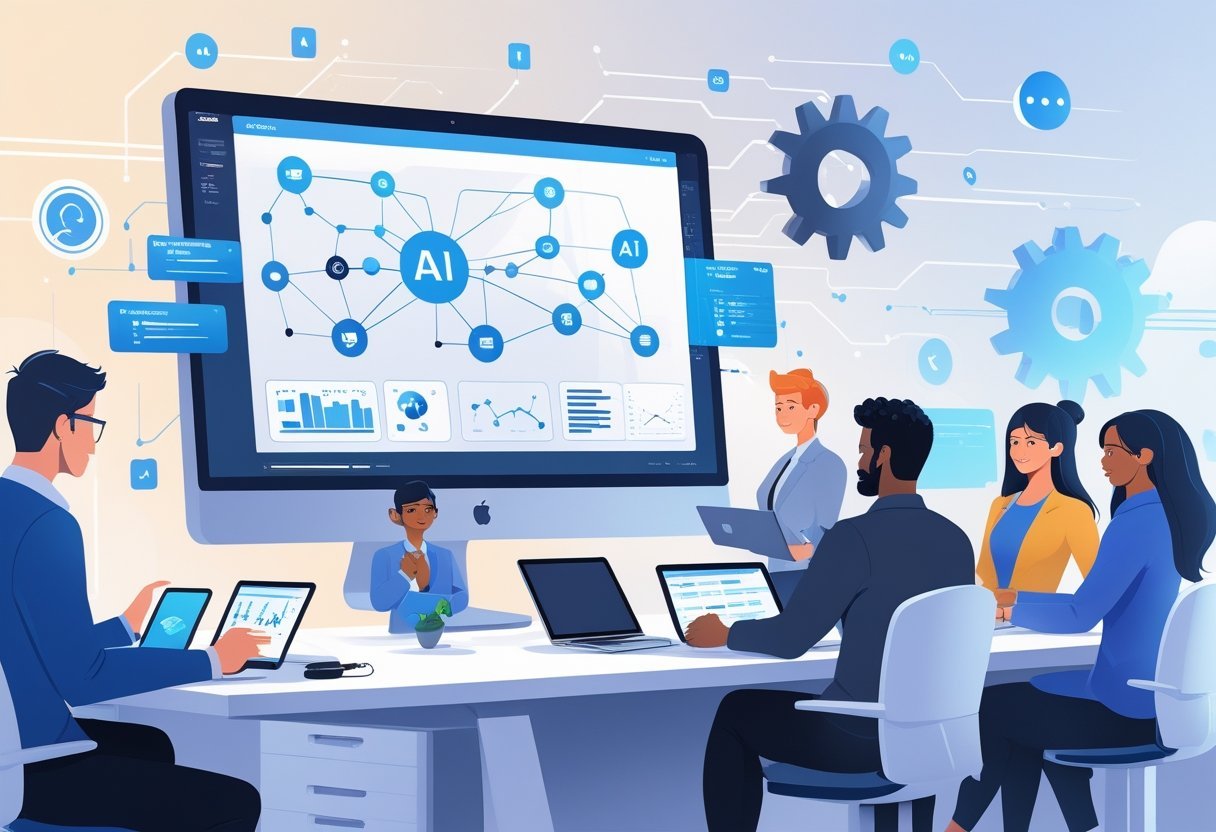If you’re looking to speed up daily tasks and remove manual steps from your work, AI workflow automation tools can help. These tools let me set up automated processes that use artificial intelligence to handle repetitive work, decisions, or data movement without needing to code. This makes it easier for me to connect apps, process information, and keep projects moving, even when I’m busy with other priorities.

With AI workflow automation, I can do things like scan emails for details, fill out forms, or route customer requests automatically. Popular platforms like Zapier, n8n, and Make offer drag-and-drop interfaces, lots of integrations, and ways to add AI steps into many kinds of workflows.
As I use these tools, I see how they help me work smarter, not harder. They can help teams stay in sync, track important updates, and make better use of data across different apps.
Key Takeaways
- AI workflow automation tools simplify repetitive tasks and cut manual effort.
- These platforms offer easy integration, customization, and help me connect many business apps.
- Using AI in workflows can improve productivity and free up time for higher-value work.
What Is an AI Workflow Automation Tool?
AI workflow automation tools use artificial intelligence to speed up tasks that are often repetitive or manual. These tools help companies reduce human error, save time, and let employees focus on more important work.
Defining AI-Powered Workflow Automation
AI-powered automation means combining artificial intelligence with workflow software to manage and improve business processes. With an AI workflow automation tool, I can set up tasks—like sending emails or moving files—to run automatically across different systems. These tools use algorithms to make decisions, analyze data, and even learn over time to get better at their tasks.
Most AI workflow automation tools let me build processes without needing to code. I can use simple drag-and-drop features or templates. This lets me automate things like customer support tickets, approvals, or data entry. AI tools often connect with other software, so all my systems work together without manual effort. This makes my daily work routine faster and more reliable. I can read more about these features in this AI workflow automation overview.
Evolution of Workflow Automation Tools
Workflow automation started with basic tools that only handled simple, rule-based tasks. In the past, I needed to set up every step myself, and the systems could not adjust if something unexpected happened.
As artificial intelligence improved, workflow automation tools gained new powers. Now, AI-powered automation can read natural language, see patterns in data, and even predict what action is needed next. These advanced tools do not just follow a script—they can adapt if the information changes or if there’s an exception. Some platforms today need little to no coding skills, making it easy for me and others in my team to set up our own automated solutions. For a full guide to this transition, I recommend this resource on the evolution of AI-powered workflow automation.
Core Features and Capabilities

AI workflow automation tools transform how I can manage work by letting me automate busywork, design multi-step tasks, use visual editors, and see important analytics. These features save time, lower errors, and help me make smarter choices.
Automate Repetitive Tasks
One of the main reasons I use an AI automation tool is to handle repetitive tasks. With these platforms, I can set up workflows that process invoices, send reminders, or sort emails automatically. This means I spend less time on busywork and more on problem solving.
Some tools, like Cflow, allow me to automate tasks even if I don’t know how to code. The AI can pick up simple jobs such as categorizing tickets, entering data, and approving requests. Rules and triggers help me customize automation to match my business needs.
By automating these tasks, I lower the chance of human error. I also keep work moving even when I’m away from my desk. Systems run around the clock and ensure that nothing falls through the cracks. This leads to higher productivity and lets my team stay focused on more valuable work.
Multi-Step Workflows
AI automation tools can connect different steps together to build full workflows. Instead of just handling single actions, I can design a chain of events that happen in order. For example, when a form is filled out, the tool can review the data, send an email, get manager approval, and update my database.
Most leading tools support multiple conditions and branching. This means that my workflows can react differently based on the data or results at each stage. I can direct requests, handle exceptions, or loop steps until certain goals are met.
This is important because many business processes have more than one step and cannot be done with simple automation. By having the ability to manage end-to-end multi-step workflows, I streamline complex operations and make sure every detail is tracked. This also helps keep my team organized and on the same page.
Drag-and-Drop Interface
A user-friendly interface makes the tool much easier for me to use. Many modern AI workflow tools use a drag-and-drop editor that lets me build workflows without writing any code. I can add actions, connect triggers, and set up decisions just by moving blocks on my screen.
This visual approach makes it easy for anyone, even those with little technical skill, to create and edit workflows. It also helps me see the whole process at a glance, so I can spot errors or missing steps quickly.
The drag-and-drop interface is especially useful for teams. Multiple users can work together to build or update workflows. If I need to change a step, I just move it or swap it out, saving time and effort. For businesses looking for no-code solutions, this is a big advantage and lowers training costs. Platforms like Cflow are known for their easy user interface.
Advanced Analytics
I use advanced analytics to track how well my workflows are running. Built-in dashboards and reports give clear data about task completion times, bottlenecks, and errors. This lets me quickly spot steps that are taking too long or where problems often occur.
Analytics help me measure success and find ways to improve. I can see which team members are handling tasks quickly and which parts of the process need better automation. Charts and visuals make it simple to understand trends over time.
Some AI workflow tools also use artificial intelligence to suggest changes based on past results. I might get alerts if a workflow is slower than normal or if tasks keep getting stuck. By using advanced analytics, I make better decisions and prove the value of automation to my company.
How AI Enhances Workflow Automation

AI automation increases speed and accuracy in business processes. I use it to lower manual work and reduce costly errors in my daily tasks.
Machine Learning in Workflow Automation
Machine learning helps automate repetitive steps by learning from large sets of data. I can rely on it to spot patterns and make predictions that humans may miss. For example, machine learning can route emails to the right department or flag out-of-the-ordinary transactions for review.
It becomes more effective over time. As more data goes through the system, its suggestions and actions improve. This helps teams work faster and with fewer mistakes.
Machine learning also sorts and manages information quickly. It can track trends and generate reports in seconds. By doing so, it allows me to focus on creative and complex work instead of tedious tasks. For more on these benefits, see how AI workflow automation increases efficiency.
Key machine learning tasks in workflow automation:
- Data entry and validation
- Routing requests
- Detecting anomalies
- Automating approvals
Role of Generative AI
Generative AI creates new content, such as text or images, that fits the needs of a specific task. I can use it to write email drafts, answer customer questions, or summarize long documents.
In workflow automation, generative AI saves time by creating personalized responses. It helps draft reports based on collected data, making information easier to understand for all team members. Generative AI also updates knowledge bases and fills out forms automatically.
Another benefit is that it works with natural language, so I can interact with systems in plain English. This breaks down communication barriers and supports better teamwork.
Common uses for generative AI in workflows:
- Automated content creation
- Customer support chatbots
- Real-time document summaries
- Filling forms and updating records
Examples show that by adding generative AI, I can speed up communication and reduce time spent on repetitive content tasks. Visit this guide on AI workflow automation to see how it is applied across industries.
Key Benefits of AI Workflow Automation Tools

AI workflow automation tools help me speed up repetitive tasks, cut down on human error, and let teams focus on higher-value work. These tools can boost how efficiently I use my resources, making my daily operations smoother and more reliable.
Streamlining Business Processes
With AI-powered automation, I can simplify multi-step workflows by letting software handle routine and predictable tasks. I often see these tools read emails, update records, or transfer files without my help. This saves me from having to do the same work over and over.
By removing manual steps, I notice fewer mistakes in my workflow. My teams can also connect different software systems together, which means data flows automatically between apps. This integration saves time and makes sure my information is always up to date.
I’ve found that automating business processes reduces stress and confusion, especially when tasks must be completed in a specific order. Clear, automated steps help me keep projects on track without needing to check on each detail. For more on improvements in workflow, I can read about AI workflow automation.
Increasing Productivity
AI automation allows me to shift my focus from busywork to more complex and creative tasks. By automating tasks like form processing, approvals, and scheduling, I free up hours every week. This lets my team accomplish more in less time.
I can also see increases in accuracy because AI systems avoid the kinds of mistakes people often make when they are tired or rushed. With higher productivity, it becomes easier for my business to scale and handle more work without adding new staff.
Using automation tools, I can measure how long each process takes, track progress, and set goals for further improvement. By using AI workflow automation, I get higher output and better results from my team’s efforts.
Eliminating Bottlenecks
When there’s a delay in my workflow, it usually comes from a single slow step or someone having too much on their plate. AI workflow automation helps me spot these bottlenecks by tracking tasks in real time. I can identify where work is piling up and fix it quickly.
Automated task assignments help distribute work more evenly among team members. AI detects when a task is stuck and will reassign it or alert me to take action. This prevents long waits and helps keep projects moving forward.
Bottlenecks are also reduced when AI can process documents, route approvals, or collect information without waiting for human input. My work streamlines, projects finish faster, and I see fewer missed deadlines. For more information on removing workflow issues, I can look at how AI eliminates bottlenecks.
Popular AI Workflow Automation Solutions

There are several strong AI workflow automation tools that make business processes faster and easier. I want to explain what makes these tools useful, which features stand out, and why someone might choose one over another.
Overview of Leading Platforms
Workflow automation tools connect apps, move data, and let me automate tasks without needing to write code. Some leading platforms in this space include Zapier, n8n, Microsoft Power Automate, and Appian.
Zapier is popular because it links many different web apps and makes building automation easy for users with little technical skill. n8n is known for its flexibility, giving developers more control and supporting both on-premise and cloud solutions. Microsoft Power Automate works best if I use Microsoft’s products, offering strong integration with Outlook, Teams, and other Microsoft apps. Appian uses AI to automate business processes and allows for adding custom automation into large organizations.
Some tools have stronger features for enterprise users, while others are best for small businesses that need simple connections between popular apps. Choosing the right platform depends on my needs, the apps I use, and how much I want to customize my automations.
ServiceNow AI Platform
The ServiceNow AI Platform is a cloud-based solution designed for companies that want to automate complex workflows, especially in IT and operations. It uses AI to streamline tasks like ticket routing, approvals, and customer requests.
One key feature is its ability to integrate with existing enterprise systems. I can automate tasks such as onboarding, incident management, and compliance checks. ServiceNow offers tools for both technical and non-technical users, using no-code and low-code interfaces for building automations.
The platform is built for scalability. Large organizations benefit from its ability to handle big volumes of requests and its secure cloud environment. Companies with regulated data can also use its compliance and security features. ServiceNow helps reduce manual work, speed up service delivery, and improve accuracy for routine business processes.
Dify and Other Tools
Dify is a newer AI workflow tool focused on making it easy to create custom AI-powered workflows for business needs. It stands out because I can design and test automations quickly, using pre-built templates and a simple drag-and-drop interface. Dify supports multiple AI models and lets me integrate them with my existing software without much coding.
If I’m looking for more options, there are several other notable platforms. n8n allows advanced customization for users who need flexibility and open-source solutions. Zapier is a favorite among small and medium businesses because of its vast app catalog and easy setup. Appian is better suited for enterprises that need both traditional automation and advanced AI features.
Each tool supports building workflows that help reduce manual work and improve productivity. My choice depends on whether I prioritize ease of use, the number of integrations, or deeper technical control. To explore more no-code AI automation options, I can look at this list of workflow automation platforms.
Workflow Design and Customization
Designing AI workflows is about using the right tools to fit specific needs. Many AI workflow automation tools now focus on making the process simpler and more flexible, with a focus on customization and ease of use.
Flow Designers
I use flow designers to visually map out how tasks and actions move through a workflow. These visual tools let me drag and drop blocks for triggers, actions, and conditions. This setup helps me clearly see how data flows between steps without having to write code.
Features like branching, parallel actions, and real-time debugging let me build more complex workflows. Some platforms also support integrating APIs or connecting data sources within the same screen. This lets me test and adjust workflows quickly.
Modern AI workflow tools like n8n have multi-step automation and agent building all on one canvas. I can also add LLMs or custom logic easily. For large teams, the ability to document and collaborate on workflows inside the designer is essential for managing updates and troubleshooting.
Low-Code and No-Code Options
I rely on low-code and no-code platforms when I need to automate tasks quickly or when coding skills are limited. Low-code platforms let me customize workflows with simple logic and rules, while still allowing for code-based changes if needed.
No-code options go further, letting me automate processes by selecting from prebuilt actions and templates. Many workflow tools, such as those listed in the Digital First AI guide, include features like AI-based suggestions and native integrations. I find this speeds up deployment and makes maintenance easier.
For example, I can add widgets, set triggers, or link data sources with just a few clicks. This is especially useful for small businesses or teams who want to automate without deep technical knowledge. These platforms make workflow management accessible and easy to scale as my needs grow.
Integrations and Collaboration Capabilities
AI workflow automation tools let me connect many apps, making my work smoother and more efficient. These integrations help me share information, assign tasks, and finish projects faster because I do not need to switch between tools or repeat actions.
Collaborative Workflow Functions
Good automation platforms support collaboration by letting me work together with teammates in real time. For example, Zapier offers powerful tools for setting up shared workflows across more than 8000 apps.
With features like shared folders, team permissions, and notifications, everyone stays updated. I can also use comment features or approval steps to make sure work moves forward only when all team members agree.
Some tools, like Cflow, require no coding, so anyone on my team can join and create workflows, even without tech skills. This helps every member contribute, whether they are from sales, IT, or support. Automations such as assigning tasks or sharing files are managed easily, so nothing is missed during handoffs.
Project and Task Management Integration
Linking my automation tool to project and task management apps saves time and reduces mistakes. For instance, n8n and Zapier can connect with Trello, Asana, Jira, or Monday.com, letting me automate steps like task creation, updates, and progress tracking.
This means I can set up workflows that create new tasks when an email comes in or move project cards based on deadlines. Automated reminders and status notifications keep everyone on track.
I can easily track progress in one dashboard instead of checking multiple tools. Integration also lets me sync data between systems, so updates in one app appear everywhere. More detail on these connection options and others can be found on Zapier’s automation platform and n8n’s workflow software.
Security, Privacy, and Governance
When I use an AI workflow automation tool, I focus on protecting data and controlling who can access information. Strict rules help guard private details and keep the system safe from outside threats. These controls apply to cloud environments and local systems.
Data Security Measures
I rely on a combination of encryption, monitoring, and compliance policies to keep data safe. Encryption ensures that files and information are unreadable without the right keys, whether in transit or stored in the cloud. Automated tools help me watch for unusual activity and alert me to any sign of a security breach.
I also check that my automation workflows follow industry standards like GDPR and CCPA. These rules guide how personal data is collected, stored, and used. Some platforms have special features for data masking and auditing, which let me make sure sensitive details stay protected at every step. Tools from companies such as Securiti offer AI-powered privacy and security automation to help me keep full control over compliance and data handling.
User Access Management
Controlling who can see or change information is a top priority for me. Strong user access management starts with identity verification, making sure only approved users log in. Tools often use multi-factor authentication and strict password rules.
I set different roles for team members, so each person gets access only to what they need. Audit logs track every action, letting me see who changed what and when. Cloud-based workflow tools often include built-in controls and reports, which make it easier for me to adjust permissions and respond to issues fast. Platforms like OneTrust highlight the value of automated user access controls to simplify compliance and lower security risks.
Use Cases and Industry Applications
Organizations use AI workflow automation tools to handle tasks in customer service, automate business processes, and improve customer experiences across many industries. These tools help companies get work done faster, lower costs, and improve satisfaction for both customers and employees.
Customer Service Automation
I rely on AI workflow automation to make customer service more efficient. Tools can route tickets, answer common questions with chatbots, and escalate issues when a human touch is needed. This reduces wait times and helps teams focus on solving the most important problems.
A common use case is in help desks. AI reads incoming messages, sorts them by topic, and recommends solutions automatically. Some systems use machine learning to understand requests in natural language, offering accurate answers and freeing staff from repetitive questions.
Companies in banking, e-commerce, and telecom use these solutions daily. For example, an online retailer can have a chatbot check order status or process refunds on its own. These improvements often lead to higher customer satisfaction and lower operating costs. For further reading on these types of applications, you can refer to detailed examples from AI workflow automation in customer support.
Robotic Process Automation (RPA)
RPA uses AI to handle repetitive office tasks. I find that it works best for jobs like data entry, payroll processing, or moving files between software systems. It follows set rules but can also use AI to handle exceptions or changes in patterns.
For example, in financial services, RPA bots read invoices, extract the right data, enter numbers into accounting systems, and check for errors. This helps avoid mistakes, saves time, and lets human workers do more valuable activities.
In manufacturing, AI-driven RPA tools track inventory, update records, and make sure supplies stay at the right levels. When combined with workflow automation software, RPA can link tasks across different departments and systems to boost productivity and accuracy. A closer look at industry use cases is available at AI workflow automation and RPA.
Improving Customer Experience
I use AI workflow automation to customize the customer journey and quickly solve problems. Tools can analyze customer behavior, suggest the best actions, and send tailored messages at the right time. This kind of automation gives customers the information and support they need without making them wait.
For example, marketing teams use automation to segment audiences and share offers based on individual interests. In service industries, AI systems track feedback, spot trends, and let staff know where improvements are needed.
These tools pull data from different channels like chat, email, and social media. They help companies respond faster and provide consistent support across every touchpoint. More ways AI enhances the customer experience with automation can be found online.
Implementation Challenges and Best Practices
Automating workflows using AI helps improve efficiency, but it is not always simple. I have found that dealing with manual processes and reducing the need for manual intervention are two key areas to focus on for a smoother implementation.
Overcoming Manual Processes
Manual processes often slow down workflow automation. Tasks done by hand, like data entry or approval requests, increase the risk of errors and take more time. When I set up AI automation, the first challenge is to identify every manual step that can be automated.
I start by mapping the entire workflow. I look for repetitive tasks or actions that follow clear rules. By listing these out, I can prioritize which to automate first. This approach lets me build quick wins and show early results.
I make sure data is standardized and easy for AI tools to use. Clean and consistent data helps avoid delays and mistakes during automation. For example, organizing documents and unifying data labels helps the tool process information accurately.
Another tip is to train teams on how the new systems work. Upskilling staff speeds up the transition and minimizes resistance to change. Investing in good training also increases adoption and reduces confusion during rollout. More tips on tackling manual process issues are covered in resources like Best Practices for Implementing AI Workflow Automation.
Minimizing Manual Intervention
Even with automation, some manual intervention is sometimes needed. My goal is to reduce this as much as possible so the system runs without constant human input.
I use clear decision rules and automate error-handling where possible. When exceptions do occur, I document them so I can address root causes over time. Regularly reviewing workflows helps me spot places where automation breaks down or still relies on people.
APIs and middleware are tools I use to connect different software systems. They help cut down on manual work by letting systems communicate automatically. This means less time spent transferring data or switching between programs.
To limit manual fixes, I monitor automation results closely. Using dashboards and alerts helps me react quickly if problems appear. Feedback loops from users can also show points where manual effort sneaks back in.
For more detailed guidance on lowering manual touchpoints, I recommend reviewing AI Workflow Automation: Best Practices, Use Cases and Benefits.
Examples and Future Trends in AI Workflow Automation
AI workflow automation is changing how companies handle routine work. I see many real-world examples in use today, and new developments are making these tools even more powerful and accessible.
Real-World Examples of Automation
Many companies now use AI workflow automation to save time and increase productivity.
For example, customer support teams rely on AI chatbots to answer common questions and route more complex problems to human agents. This reduces wait times and improves customer satisfaction. Finance departments use AI-powered tools to check invoices for errors, flag fraud, and speed up approvals.
In healthcare, AI can help schedule appointments by reading emails or forms automatically. Human resources teams use AI to screen job applications faster and find strong candidates. Manufacturing plants rely on AI to monitor equipment health and predict maintenance needs. These examples show how AI workflows can perform tasks that once took hours in just a few minutes or even seconds. You can see more use cases and best practices at AI workflow automation examples and automation practices.
| Industry | AI Workflow Example |
|---|---|
| Customer Service | Chatbots, ticket routing |
| Finance | Invoice processing, fraud detection |
| Healthcare | Appointment scheduling, data entry |
| HR | Resume screening, onboarding |
| Manufacturing | Equipment monitoring, predictive analysis |
Emerging Trends and Innovations
I notice that companies are investing in new AI workflow trends to further change how work gets done.
One big trend is the rise of no-code and low-code platforms. These tools let anyone build AI workflows without needing programming skills. Newer AI models that use natural language processing (NLP) are making it easier for software to understand written content and automate tasks. Generative AI can even write reports or create documents based on input data.
AI is also improving workflow automation by making tools smarter. For example, these tools can now learn from past data to make better decisions in real-time. There’s also a shift toward connecting multiple AI tools so they work together in a single, seamless system.
By 2025, experts expect more teams to use these advanced solutions, making everyday business tasks smoother and more efficient. Learn more about these trends at AI workflow automation trends and how businesses are adapting in the future of workflow automation.
Frequently Asked Questions
I see a lot of interest in how AI workflow automation tools work, their features, and their cost. People also want to know about integration with business systems and the differences between AI and regular automation.
What features should you look for in an AI workflow automation tool?
When I pick an AI workflow automation tool, I look for features like task automation, easy integration options, and user-friendly dashboards. AI capabilities such as learning from patterns, handling unstructured data, and providing actionable insights are important. I also check if the tool offers custom workflows and reliable security.
How does AI enhance traditional workflow automation?
AI lets software handle more complex tasks by understanding data and making predictions. Unlike basic automation, AI can learn from past actions and improve over time. This means I can use these tools to reduce manual errors and speed up decision-making, as explained in this AI workflow automation guide.
What are some open-source AI workflow automation tools available?
Some open-source options I consider include Apache Airflow for managing workflows and Camunda for process automation. These tools may need more setup but give me more control. I sometimes find more suggestions and discussions from communities like Reddit, where users share their experiences.
Can AI workflow automation tools integrate with existing business systems?
Most tools I have researched are built to integrate with common business software, like CRMs or data storage services. This lets me connect workflows across my entire organization. Integration support is very common, as seen in many workflow automation FAQs.
What is the cost of implementing an AI workflow automation tool?
Prices vary based on the tool’s features, the number of users, and the level of customization. Some open-source tools are free but may require extra work for setup and maintenance. Business-focused platforms often charge monthly or yearly fees, and the total cost can increase with added support or advanced AI features.
How do AI workflow automation tools differ from standard automation software?
AI tools do more than just follow fixed rules. They can adapt to changes, learn from experience, and process different types of data, like images and text, which basic automation tools cannot. This means I get smarter task automation and better decision support compared to standard workflow tools, as explained in this complete guide to AI workflow automation.



